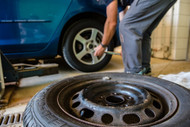Reading Your Car's Tire Tread: What You Should Know
7th Jan 2019

Tire Tread
Each year, tire blowouts cause more than 10,000 non-fatal injuries and 400 fatalities in the United States, according to the National Highway Transportation Safety Administration (NHTSA). While there's no way to completely prevent blowouts, you can lower the risk of this happening to you by ensuring your tires have adequate tread. About once every one or two weeks, take a look at the tread of all your tires. Worn or missing tread indicates the respective tire needs to be replaced. However, tread can reveal other things about your tires and even your car itself, such as the following.
Middle Tread Wear
If the tread is only worn in the middle of the tire -- with the inner and outer edges having adequate tread -- it usually indicates overinflation. Tires are designed to hold a specific amount of air pressure, usually around 30 to 35 pounds per square inch (PSI). If you overinflate a tire, the excess pressure will cause it to wear more quickly in the middle rather than the inner and outer edges. Over time, you may discover the middle of the tire smooth from the loss of tread.
Inner and Outer Tread Wear
When inspecting your tires, look at the inner and outer edges to see if it contains tread. While tread wear in the middle indicates overinflated tires, inner and outer tread wear indicates underinflated tires. Some people assume that driving on underinflated tires isn't a problem. The truth, however, is that it can affect your car in several ways. With underinflated tires, you'll experience poor fuel economy, poor handling and an increased risk of tread wear. To prolong the lifespan of your tires, inflate them to the appropriate PSI as recommended by the manufacturer.
Diagonal Tread Wear
Diagonal tread wear, on the other hand, usually means that your wheels are out of alignment. If a wheel is pointed directly forward in conjunction with the other wheels, it will result in diagonal tread wear. Eventually, all the tire's tread may be affected. At first, however, only diagonal streaks of worn tread will form, indicating the need for a wheel alignment ASAP.
Random Spots of Tread Wear
Finally, if you see ransom spots of tread wear, it could indicate an out-of-balance wheel. A wheel balance isn't the same as a wheel alignment. Even if you get an alignment, you may still need to have your wheels balanced. In fact, Goodyear Tires recommends drivers have their wheels balanced about once every 3,000 to 6,000 miles.


